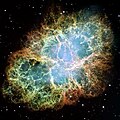Fájl:Crab Nebula.jpg
Megjelenés

Az előnézet mérete: 600 × 600 képpont További felbontások: 240 × 240 képpont | 480 × 480 képpont | 768 × 768 képpont | 1 024 × 1 024 képpont | 2 048 × 2 048 képpont | 3 864 × 3 864 képpont.
Eredeti fájl (3 864 × 3 864 képpont, fájlméret: 13,84 MB, MIME-típus: image/jpeg)
Fájltörténet
Kattints egy időpontra, hogy a fájl akkori állapotát láthasd.
| Dátum/idő | Bélyegkép | Felbontás | Feltöltő | Megjegyzés | |
|---|---|---|---|---|---|
| aktuális | 2012. november 25., 15:56 |  | 3 864 × 3 864 (13,84 MB) | Hawky.diddiz | Lossless optimization |
| 2012. május 17., 11:13 |  | 3 864 × 3 864 (14,61 MB) | Metrónomo | Higher quality | |
| 2009. június 20., 10:31 |  | 3 864 × 3 864 (6,18 MB) | Tryphon | Higher resolution. | |
| 2006. március 9., 22:26 |  | 2 224 × 2 212 (3,08 MB) | Stianbh | larger version | |
| 2006. január 16., 01:35 |  | 400 × 400 (23 KB) | DragonFire1024 | Image: A New View of the Helix Nebula Source: http://hubblesite.org/gallery/album/entire_collection/pr2004032d/ Copyright Notice: Material credited to STScI on this site was created, authored, and/or prepared for NASA under Contract NAS5-26555. Unless |
Fájlhasználat
Az alábbi lapok használják ezt a fájlt:
Globális fájlhasználat
A következő wikik használják ezt a fájlt:
- Használata itt: af.wikipedia.org
- 1054
- Wikipedia:Uitgesoekte herdenkings/22 April
- Wikipedia:Uitgesoekte herdenkings/Julie
- Wikipedia:Uitgesoekte herdenkings/April
- Wikipedia:Uitgesoekte herdenkings/4 Julie
- Supernova
- Ster
- Wikipedia:Beeld van die week/2012
- Wikipedia:Voorbladbeeld week 2 2012
- Newel
- Kompakte ster
- Veranderlike ster
- Lys van Messier-voorwerpe
- Krapnewel
- Portaal:Sterrekunde/Inleiding
- Portaal:Sterrekunde
- Hemelliggaam
- Lys van planetêre newels
- SN 1054
- Supernova-oorblyfsel
- Sterevolusie
- Használata itt: als.wikipedia.org
- Használata itt: am.wikipedia.org
- Használata itt: anp.wikipedia.org
- Használata itt: ar.wikipedia.org
- مجرة
- نجم
- سنة
- تطور النجوم
- ثلاثي الكربون
- فجر
- مستعر أعظم
- بوابة:علم الفلك/مقالة مختارة
- شهاب
- مطلع مستقيم
- جمعية منسا الدولية
- علم الفلك خارج المجري
- عنقود نجمي
- فيلا (أقمار اصطناعية)
- الشلياق
- خرزات بيلي
- راية الأرض
- سمت
- نظرية الحالة الثابتة
- حياة الحيوان الكبرى
- توهج القمر الصناعي
- بوابة:الفيزياء/بوابات ذات علاقة
- الظهر
- اقتران (علم الفلك)
- علم الهيئة
A fájl globális használatának megtekintése

